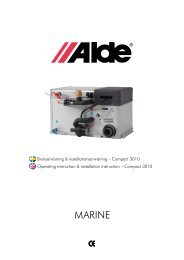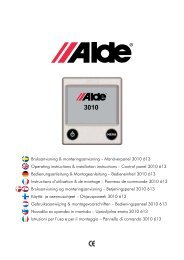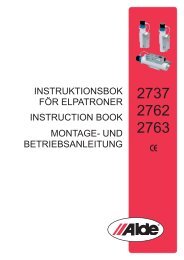Bruksanvisning & installationsanvisning – Compact 3010 Operating ...
Bruksanvisning & installationsanvisning – Compact 3010 Operating ...
Bruksanvisning & installationsanvisning – Compact 3010 Operating ...
Create successful ePaper yourself
Turn your PDF publications into a flip-book with our unique Google optimized e-Paper software.
tHe Heating Cartridges<br />
All <strong>Compact</strong> <strong>3010</strong>s are fitted with two<br />
230 V heating cartridges with a maximum<br />
output of either 2100 or 3150 W. Select<br />
the heating cartridge output on the control<br />
panel.<br />
Always check that the input fuse of the<br />
vehicle has the correct amperage in<br />
relation to the selected output. Note these<br />
ratings are for the boiler only.<br />
1050 W requires a 6 amp fuse.<br />
2100 W requires a 10 amp fuse.<br />
3150 W requires a 16 amp fuse.<br />
tHe CirCuLation PumP<br />
A circulation pump is required to circulate<br />
the heated glycol fluid. There are three<br />
types of circulation pumps. A 12 V circulation<br />
pump can be fitted in the expansion<br />
tank, a 230 V or a 12 V circulation pump<br />
can be fitted on the boiler. If more than<br />
one circulation pump is installed, the<br />
required circulation pump is selected via<br />
the control panel.<br />
The control panel’s room thermostat is<br />
used to control the circulation pump, i.e.<br />
switching on or off, depending on the<br />
heating requirement.<br />
system temPerature<br />
The boiler is set to a system temperature<br />
of 80°C, i.e. the temperature of the glycol<br />
fluid as it circulates in the heating system.<br />
air CirCuLation<br />
In order to achieve the best possible result<br />
from the principle of convected heat, it is<br />
important to allow air to circulate freely<br />
under bunks, and behind backrests and<br />
wall-mounted cabinets. If the vehicle has<br />
a fitted carpet, ensure that the carpet does<br />
not obstruct the air supply to the radiators.<br />
It is just as important that cushions or<br />
blankets do not interrupt the flow of air<br />
behind backrests and wall cabinets.<br />
10<br />
Air stream<br />
Convectors<br />
maintaining tHe Heating<br />
system<br />
Wintercamping<br />
While camping during the winter, ensure<br />
that the flue is kept clear of snow and ice,<br />
since the inlet air to the LPG boiler enters<br />
through the flue. Do not start the LPG<br />
boiler until the flue is completely free of<br />
snow. A flue extension (part no. 3000 320)<br />
for fitting on the roof is recommended for<br />
winter camping.<br />
the LPg system<br />
The LPG system should be checked regularly<br />
by a professional, who will ensure<br />
that there are no leaks from connections<br />
or hoses.<br />
LPG hoses should be changed according<br />
to national regulations, maximum of<br />
five years. Check the date stamp on the<br />
hose. Hose has a propensity to dry out<br />
and crack.<br />
To increase safety, we recommend fitting<br />
an Alde leak gauge, type 4071, as close<br />
as possible to the pressure reduction<br />
valve.<br />
Leak gauge, type 4071<br />
the heating system<br />
Regularly check the heating system’s<br />
fluid level in the expansion tank. The level<br />
should be about 1cm above the minimum<br />
indicator in a cold tank.<br />
The heating system should be filled with a<br />
mixture of water and glycol.<br />
For preference, use high quality readymixed<br />
glycol (with inhibitor) intended for<br />
use in aluminium heating systems.<br />
If using concentrated glycol, the mixture<br />
should consist of 60% water and<br />
40% glycol. If the heating system will be<br />
exposed to temperatures below -25°C, the<br />
glycol content must be increased, but not<br />
to more than 50%.<br />
Any vessels used for the liquid must be<br />
spotlessly clean, and the pipes in the<br />
heating system must be free of contamination.<br />
This will prevent the growth of<br />
bacteria in the system.<br />
The glycol mixture should be changed<br />
every second year, since its ability to<br />
protect against corrosion, for example, will<br />
deteriorate.<br />
The glycol content should be checked<br />
before topping up with new liquid. This will<br />
ensure that the concentration of glycol in<br />
the mixture is not too high.<br />
If the fluid level in the expansion tank falls<br />
for reasons other than evaporation, please<br />
check all joints, drain cocks and bleeder<br />
screws to ensure that they are not leaking.<br />
If the glycol-water mixture leaks out, rinse<br />
with water and wipe up.<br />
Never allow the heating system to stand<br />
empty of glycol.<br />
FiLLing tHe system WitH<br />
gLyCoL FLuid<br />
nb! Any vessels used to carry the fluid<br />
must be spotlessly clean and the pipes in<br />
the system must be free of contamination.<br />
This will prevent the growth of bacteria in<br />
the system.<br />
The system is filled through the expansion<br />
tank, either manually or using the Alde filling<br />
pump which both tops up and bleeds<br />
the system. For manual filling, unfasten<br />
the circulation pump nut (R) and lift the<br />
pump (S) out of the tank. Slowly pour the<br />
glycol mixture into the tank. Bleed the<br />
system. Top up with more liquid if the level<br />
has fallen after bleeding. Bleed a newlyfilled<br />
system regularly during the first days<br />
the heating system is in operation.<br />
S<br />
R







